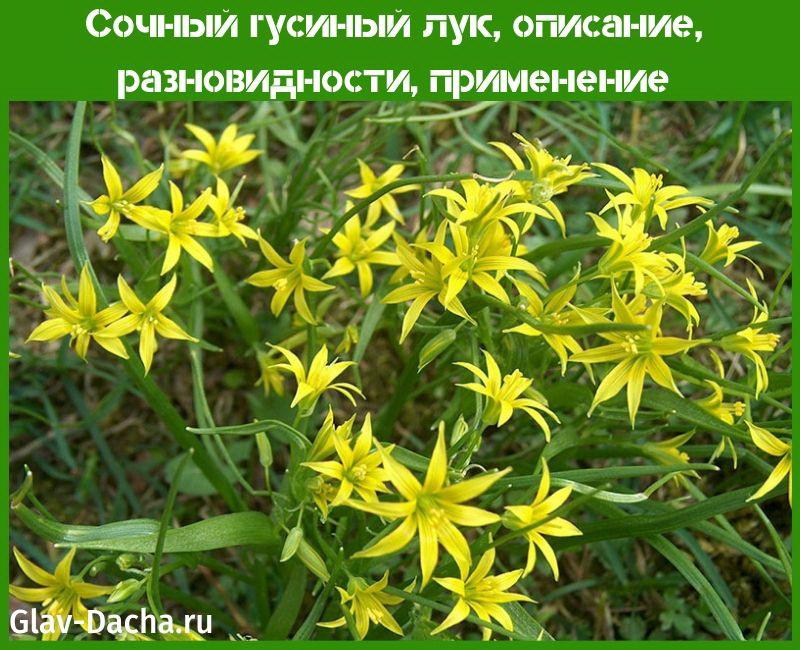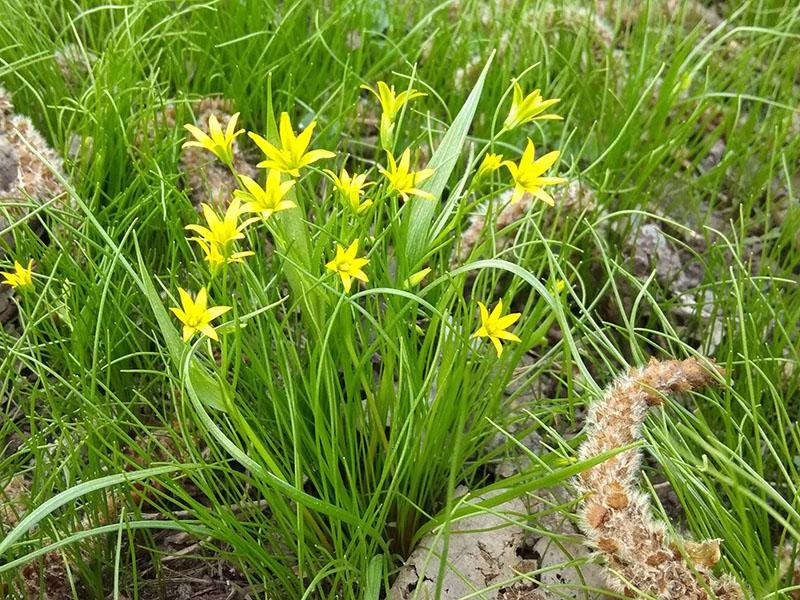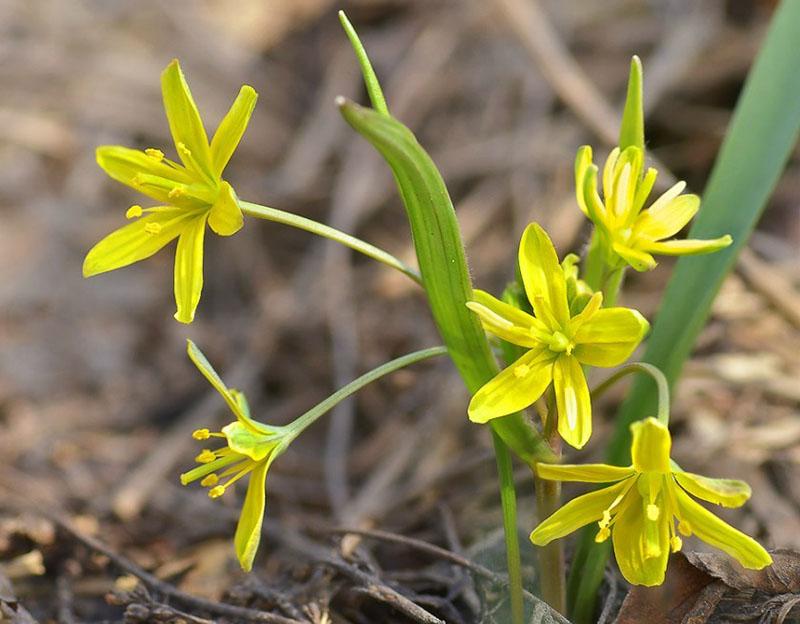Juicy goose onions, description, varieties, application
 In early spring, when there is still snow, the earth gives people greenery and flowers. At this time, a juicy goose onion appears along with snowdrops. The plant attracts birds returning from warm regions, who eat it with pleasure. And people use the culture for preparing spring meals and for medicinal purposes. Let's take a closer look at this unique primrose.
In early spring, when there is still snow, the earth gives people greenery and flowers. At this time, a juicy goose onion appears along with snowdrops. The plant attracts birds returning from warm regions, who eat it with pleasure. And people use the culture for preparing spring meals and for medicinal purposes. Let's take a closer look at this unique primrose.
External features of the plant

However, grass is popularly called:
- goose onions;
- yellow flowers;
- bird bow;
- viper bow;
- gosyator.
 A detailed description and photo of a goose onion helps to see it in all its glory and appreciate its merits.
A detailed description and photo of a goose onion helps to see it in all its glory and appreciate its merits.
The plant belongs to the Liliaceae family and consists of the following elements:
- main erect stem, up to 30 cm high;
- basal leaf plate of a linear nature;
- several lanceolate stem leaves;
- umbellate inflorescences, consisting of 5-10 buds;
- underground bulbs.
 Goose flowers form 6 delicate petals. The inside of them is painted in a bright golden color. The outer surface has a greenish tint. In clear weather, the buds fully open and glow dazzlingly against the backdrop of greenery. Stay tightly closed at night and on cloudy days. Flowering begins in April or May. The buds resemble miniature tulips yellow color.
Goose flowers form 6 delicate petals. The inside of them is painted in a bright golden color. The outer surface has a greenish tint. In clear weather, the buds fully open and glow dazzlingly against the backdrop of greenery. Stay tightly closed at night and on cloudy days. Flowering begins in April or May. The buds resemble miniature tulips yellow color.
 After successful pollination, fruits are formed in the form of oval-shaped bolls. The seeds ripen for about a year, exuding a specific smell. Thanks to this, hundreds ants carry them in different directions.
After successful pollination, fruits are formed in the form of oval-shaped bolls. The seeds ripen for about a year, exuding a specific smell. Thanks to this, hundreds ants carry them in different directions.
 The graceful bulb hidden underground has an oblong shape. From above it is protected by gray-brown scales. Small "babies" grow next to the mother's part, which are used for reproduction.
The graceful bulb hidden underground has an oblong shape. From above it is protected by gray-brown scales. Small "babies" grow next to the mother's part, which are used for reproduction.
Daughter bulbs are also formed in the axils of the leaf plates, which are located outside the plant.
Common species and growing areas
 Biologists count more than 100 different types of goslings. They differ mainly in the number and shape of its underground part.
Biologists count more than 100 different types of goslings. They differ mainly in the number and shape of its underground part.
The following varieties are found in nature:
- yellow (ordinary);

- small (peduncle reaches 15 cm);

- ruddy or reddish (has a single onion);

- bulbous (forms many daughter bulbs);

- German (the root consists of 2 tubers at once: large and small parts);

- granular onions (the underground part is colored brown).

A small species of eider is used to decorate flower beds. In early spring, the plant forms pretty green lawns that glow with yellow flowers. The culture is propagated by dividing the bulbs, which are planted in mid-autumn. And where does goose onions grow in nature? Let's go on a fascinating journey across our unique planet.
It is best to grow flowers in open areas where there is a lot of sunlight and no drafts.
A huge number of goose onions are found in northern Africa. There it grows on endless meadows and banks of the Nile. The plant pleases with its presence and Europeans.
Bright yellow flowers greet spring:
- on forest edges;
- among spacious pastures;
- in the thick of birch and oak groves;
- near small streams and deep rivers.
Some species grow even beyond the Arctic Circle and in Siberia.They are resistant to cold, therefore pleasing to the eye in such places. The people of China, Kazakhstan and Mongolia know and appreciate the goose onion. This is truly a unique plant!
Valuable properties and applications
 The name of the culture indicates the content of useful elements in it.
The name of the culture indicates the content of useful elements in it.
Scientists equate it with garlic, since a number of elements were found in the shoots and the bulb:
- ascorbic acid;
- vitamins of group B, PP, E;
- essential oils;
- sulfur;
- carotene;
- inulin.
Thanks to a unique set of components, medicinal preparations are made on the basis of the gooseberry.
They are used to fight diseases:
- hepatitis;
- asthma;
- epilepsy.
 Goose onions have antiseptic properties. Therefore, it is used to treat deep wounds and internal formations. Decoctions from the plant are used to lower blood glucose levels.
Goose onions have antiseptic properties. Therefore, it is used to treat deep wounds and internal formations. Decoctions from the plant are used to lower blood glucose levels.
The drink is prepared from 2 ingredients:
- water (100 g);
- goose bulbs (1 tbsp. l).
The main product is cut into small pieces or grind into gruel. Then pour in hot water and cook over moderate heat for about 5-6 minutes. The medicine is insisted for about 2 hours, after which it is filtered. Take 1 tbsp. spoon after each meal.
 Puree from goose bulbs is used to strengthen the scalp. It is thoroughly rubbed into the skin, and after 30 minutes, washed off with shampoo. To cope with the vitamin deficiency in the body after a long winter, goose leaves are added to various dishes. When a unique plant with bright yellow flowers appears on the lawns in early spring, you should pay attention to it. It will give not only positive emotions, but also strengthen health.
Puree from goose bulbs is used to strengthen the scalp. It is thoroughly rubbed into the skin, and after 30 minutes, washed off with shampoo. To cope with the vitamin deficiency in the body after a long winter, goose leaves are added to various dishes. When a unique plant with bright yellow flowers appears on the lawns in early spring, you should pay attention to it. It will give not only positive emotions, but also strengthen health.